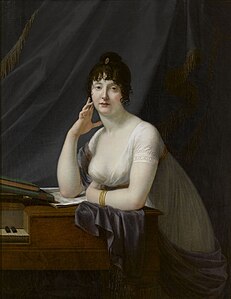| Revision as of 04:22, 13 January 2025 editLord Cornwallis (talk | contribs)Autopatrolled, Extended confirmed users, Pending changes reviewers460,234 edits →Gallery← Previous edit | Latest revision as of 04:29, 13 January 2025 edit undoLord Cornwallis (talk | contribs)Autopatrolled, Extended confirmed users, Pending changes reviewers460,234 editsNo edit summary | ||
| (2 intermediate revisions by the same user not shown) | |||
| Line 4: | Line 4: | ||
| The Emperor was also represented in portraiture by '']'' by ] | The Emperor was also represented in portraiture by '']'' by ] | ||
| <ref>Porterfield & Siegfried p.98-100</ref> as was his sister ] who had sat for ]. Ingres also submitted a noted '']'' of himself.<ref>Rifkin p.99</ref> Also on display were ] paintings such as '']'' by ] and ''Theseus and Pirithous'' by ].<ref>Porterfield & Siegfried p.97</ref> | <ref>Porterfield & Siegfried p.98-100</ref> as was his sister ] who had sat for ]. Ingres also submitted a noted '']'' of himself.<ref>Rifkin p.99</ref> Also on display were ] paintings such as '']'' by ] and ''Theseus and Pirithous'' by ].<ref>Porterfield & Siegfried p.97</ref> ] was awarded a ] for her painting of ]. ] drew praise for his ] ''Honours Rendered to Raphael on His Deathbed''.<ref>Siegel p.107</ref> | ||
| Critics were limited in what they could say by increasingly firm ] by the Napoleonic authorities.<ref>Porterfield & Siegfried p.98</ref> It was followed by the ] which continued its theme of celebrating the Napoleonic regime and its military triumphs. | Critics were limited in what they could say by increasingly firm ] by the Napoleonic authorities.<ref>Porterfield & Siegfried p.98</ref> It was followed by the ] which continued its theme of celebrating the Napoleonic regime and its military triumphs. | ||
| Line 34: | Line 34: | ||
| * Porterfield, Todd & Siegfried, Susan L. ''Staging Empire: Napoleon, Ingres, and David''. Pennsylvania State University, 2006. | * Porterfield, Todd & Siegfried, Susan L. ''Staging Empire: Napoleon, Ingres, and David''. Pennsylvania State University, 2006. | ||
| * Rifkin, Adrian. ''Ingres Then, and Now''. Routledge, 2005. | * Rifkin, Adrian. ''Ingres Then, and Now''. Routledge, 2005. | ||
| *Siegel, Jonah. ''Material Inspirations: The Interests of the Art Object in the Nineteenth Century and After''. Oxford University Press, 2020. | |||
| ] | ] | ||
Latest revision as of 04:29, 13 January 2025
1806 art exhibition in Paris
The Salon of 1806 was an art exhibition held at the Louvre in Paris. During the Napoleonic era the Salon was held biannually and featured paintings, sculptures and engravings. Military conquest was the theme of the exhibition, featuring numerous references to the campaigns of Napoleon. Amongst these were a bust of Napoleon by Lorenzo Bartolini and the battle paintings The Battle of Aboukir by Antoine-Jean Gros, The Battle of the Pyramids by Louis-François Lejeune and Napoleon Honours Unfortunate Courage by Jean Baptiste Debret in which the Emperor is shown saluting the bravery of his wounded Austrian enemies. Jean Broc's The Death of General Desaix portrays the death of Louis Desaix at the Battle of Marengo.
The Emperor was also represented in portraiture by Napoleon I on His Imperial Throne by Jean-Auguste-Dominique Ingres as was his sister Pauline Bonaparte who had sat for Robert Lefèvre. Ingres also submitted a noted Self-portrait of himself. Also on display were neoclassical paintings such as Scene from a Deluge by Anne-Louis Girodet de Roussy-Trioson and Theseus and Pirithous by Angélique Mongez. Henriette Lorimier was awarded a gold medal for her painting of Joan of Navarre. Pierre-Nolasque Bergeret drew praise for his history painting Honours Rendered to Raphael on His Deathbed.
Critics were limited in what they could say by increasingly firm censorship by the Napoleonic authorities. It was followed by the Salon of 1808 which continued its theme of celebrating the Napoleonic regime and its military triumphs.
Gallery
-
 Self-portrait by Jean-Auguste-Dominique Ingres
Self-portrait by Jean-Auguste-Dominique Ingres
-
 A Young Village Woman by Jean Antoine Laurent
A Young Village Woman by Jean Antoine Laurent
-
 Malvina Lamenting the Death of Oscar by Elizabeth Harvey
Malvina Lamenting the Death of Oscar by Elizabeth Harvey
-
 The Battle of the Pyramids by Louis-François Lejeune
The Battle of the Pyramids by Louis-François Lejeune
-
 The Battle of Aboukir by Antoine-Jean Gros
The Battle of Aboukir by Antoine-Jean Gros
-
 The Death of General Desaix by Jean Broc
The Death of General Desaix by Jean Broc
-
 The Five Senses by Constance Marie Charpentier
The Five Senses by Constance Marie Charpentier
-
 Scene from a Deluge by Anne-Louis Girodet de Roussy-Trioson
Scene from a Deluge by Anne-Louis Girodet de Roussy-Trioson
-
 Theseus and Pirithous by Angélique Mongez
Theseus and Pirithous by Angélique Mongez
-
 A Knight at Prayer in a Chapel, Preparing Himself for Combat by Fleury François Richard
A Knight at Prayer in a Chapel, Preparing Himself for Combat by Fleury François Richard
-
 Joan of Navarre and son Arthur by Henriette Lorimier
Joan of Navarre and son Arthur by Henriette Lorimier
-
 Portrait of Pauline Bonaparte by Robert Lefèvre
Portrait of Pauline Bonaparte by Robert Lefèvre
-
 Portrait of Joseph Léopold Saget by Élise Bruyère
Portrait of Joseph Léopold Saget by Élise Bruyère
-
 Portrait of Philibert Rivière by Jean-Auguste-Dominique Ingres
Portrait of Philibert Rivière by Jean-Auguste-Dominique Ingres
-
 Portrait of Madame Arnault by Eugénie Servières
Portrait of Madame Arnault by Eugénie Servières
References
- Porterfield & Siegfried p.96-97
- Porterfield & Siegfried p.97
- Germani p.173
- Porterfield & Siegfried p.98-100
- Rifkin p.99
- Porterfield & Siegfried p.97
- Siegel p.107
- Porterfield & Siegfried p.98
Bibliography
- Germani, Ian. Dying for France: Experiencing and Representing the Soldier’s Death, 1500–2000. McGill-Queen's Press, 2023.
- Porterfield, Todd & Siegfried, Susan L. Staging Empire: Napoleon, Ingres, and David. Pennsylvania State University, 2006.
- Rifkin, Adrian. Ingres Then, and Now. Routledge, 2005.
- Siegel, Jonah. Material Inspirations: The Interests of the Art Object in the Nineteenth Century and After. Oxford University Press, 2020.